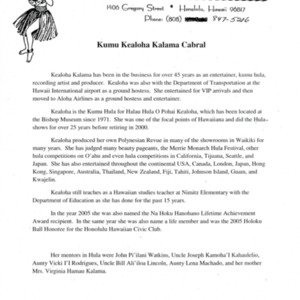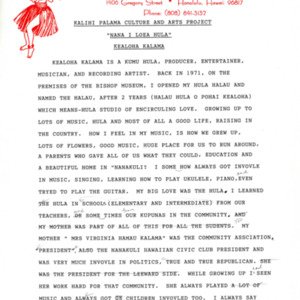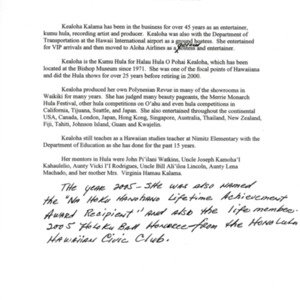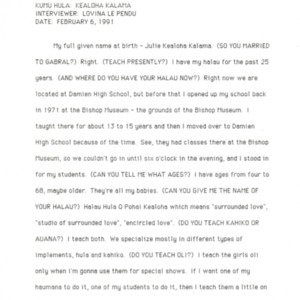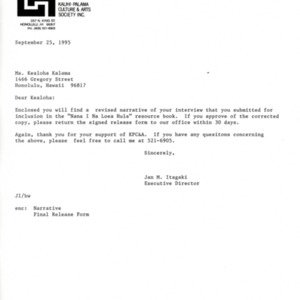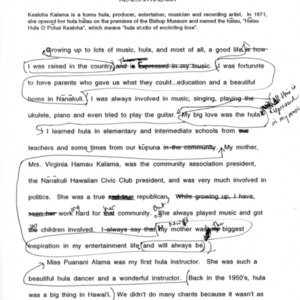Kealoha Kalama
Title
Kealoha Kalama
Subject
Nā Kumu Hula Kealoha Kalama - Nānā I Nā Loea Hula Volume 2 Page 47
Description
Kealoha Kahuna is a kumu hula, producer, entertainer, musician, and recording artist. In 1971 on the premises of the Bishop Museum, she opened Hālau Hula O Pohai Kealoha which means “hula studio of encircling love.”
I was raised in the country growing up with lots of music and hula. It was a good life and I was fortunate to have parents who gave us what they could. I was always involved in music: singing, playing the ukulele, piano, and guitar.
My mother Mrs. Virginia Hainan Kalama was, and will always be, the biggest inspiration in my entertainment life. She was the community association president, the Nānākuli Hawaiian Civic Club president, and was very much involved in politics. She was a true Republican who worked hard for her community and she always enjoyed playing music.
My big love in those days was the hula. I learned to dance in elementary and intermediate schools from teachers and sometimes from our kupuna. Back in the 1950s hula was a big thing in Hawaiʻi. Miss Puanani Alama was my first hula instructor, and she was such a beautiful hula dancer and a wonderful instructor. We didn’t do many chants because it wasn’t as important as it is today. I also met John Pi'ilani Watkins and was very honored to perform for his group. Brother John was such a great composer, beautiful singer, musician, and fantastic entertainer. He w as my kumu in hula and music. Back then in the late Fifties we put on shows at the military bases, the old Kapahulu Tavern, the Waikīkī Sands Club, and on the neighbor islands.
I met Joseph Kamoha‘i Kahaulelio through Brother John. Joseph and Aunty Pauline Kekahuna were looking for hula dancers for their big show in the Princess Ka‘iulani and the Moana Hotels. Before I started taking hula lessons from Joseph Kahaulelio, John Piʻilani Watkins gave me his blessing to learn ʻōlapa. I also danced for Aunty Vicky I‘i, Aunty Genoa Keawe, Uncle Bill Aliʻiloa Lincoln, Louise Kaleiki. Leina‘ala Haile, and Leina‘ala Simerson. I was blessed to have been associated with many of Hawaiʻi’s outstanding kumu hula and entertainers.
From 1969 to 1971 I coordinated the Hawaiian revue at the beautiful Ulumau Village in Kāne‘ohe. I also opened a Polynesian revue for the Waikiki Resort Hotel and I produced shows for the Reef Hotel. Hyatt Regency Hotel, Halekūlani Hotel, Bishop Museum, and Hawaiʻi’s Visitors Bureau. I was also the lead dancer for Aunty Bosalie Stevenson whom I travelled with to Kwajalein, Johnson Island, Okinawa, and other countries.
For the past few years I’ve been with the Department of Education’s Kupuna Hawaiian Studies Program at the Admiral Nimitz Elementary School. It has really been a challenge to teach military children but I really enjoy helping them learn our culture, sing Hawaiian songs, and especially learn how to pronounce our Hawaiian words.
Having been a judge for many hula competitions in Honolulu, Hilo, and on the mainland, I found our culture to be popular all over the world and so many young instructors are coming out from all over the place. I find a change in our beautiful hula and our ‘ōlapa, and I guess it has to be because it’s so competitive.
After twenty-five years I still have my hālau Hālau Hula O Pohai Kealoha. My wonderful husband Wilfred T. Cabral has supported me with his love and has always been there to help me. I’ve made sure that I tried my best in whatever I did, and I thank the people who helped me throughout the years. After being in the entertainment field for over thirty-five years, I feel that I’ve paid my dues.
I was raised in the country growing up with lots of music and hula. It was a good life and I was fortunate to have parents who gave us what they could. I was always involved in music: singing, playing the ukulele, piano, and guitar.
My mother Mrs. Virginia Hainan Kalama was, and will always be, the biggest inspiration in my entertainment life. She was the community association president, the Nānākuli Hawaiian Civic Club president, and was very much involved in politics. She was a true Republican who worked hard for her community and she always enjoyed playing music.
My big love in those days was the hula. I learned to dance in elementary and intermediate schools from teachers and sometimes from our kupuna. Back in the 1950s hula was a big thing in Hawaiʻi. Miss Puanani Alama was my first hula instructor, and she was such a beautiful hula dancer and a wonderful instructor. We didn’t do many chants because it wasn’t as important as it is today. I also met John Pi'ilani Watkins and was very honored to perform for his group. Brother John was such a great composer, beautiful singer, musician, and fantastic entertainer. He w as my kumu in hula and music. Back then in the late Fifties we put on shows at the military bases, the old Kapahulu Tavern, the Waikīkī Sands Club, and on the neighbor islands.
I met Joseph Kamoha‘i Kahaulelio through Brother John. Joseph and Aunty Pauline Kekahuna were looking for hula dancers for their big show in the Princess Ka‘iulani and the Moana Hotels. Before I started taking hula lessons from Joseph Kahaulelio, John Piʻilani Watkins gave me his blessing to learn ʻōlapa. I also danced for Aunty Vicky I‘i, Aunty Genoa Keawe, Uncle Bill Aliʻiloa Lincoln, Louise Kaleiki. Leina‘ala Haile, and Leina‘ala Simerson. I was blessed to have been associated with many of Hawaiʻi’s outstanding kumu hula and entertainers.
From 1969 to 1971 I coordinated the Hawaiian revue at the beautiful Ulumau Village in Kāne‘ohe. I also opened a Polynesian revue for the Waikiki Resort Hotel and I produced shows for the Reef Hotel. Hyatt Regency Hotel, Halekūlani Hotel, Bishop Museum, and Hawaiʻi’s Visitors Bureau. I was also the lead dancer for Aunty Bosalie Stevenson whom I travelled with to Kwajalein, Johnson Island, Okinawa, and other countries.
For the past few years I’ve been with the Department of Education’s Kupuna Hawaiian Studies Program at the Admiral Nimitz Elementary School. It has really been a challenge to teach military children but I really enjoy helping them learn our culture, sing Hawaiian songs, and especially learn how to pronounce our Hawaiian words.
Having been a judge for many hula competitions in Honolulu, Hilo, and on the mainland, I found our culture to be popular all over the world and so many young instructors are coming out from all over the place. I find a change in our beautiful hula and our ‘ōlapa, and I guess it has to be because it’s so competitive.
After twenty-five years I still have my hālau Hālau Hula O Pohai Kealoha. My wonderful husband Wilfred T. Cabral has supported me with his love and has always been there to help me. I’ve made sure that I tried my best in whatever I did, and I thank the people who helped me throughout the years. After being in the entertainment field for over thirty-five years, I feel that I’ve paid my dues.
Citation
“Kealoha Kalama,” Nā Kumu Hula Archive, accessed February 23, 2025, https://nakumuhula.org/archive/items/show/121.






